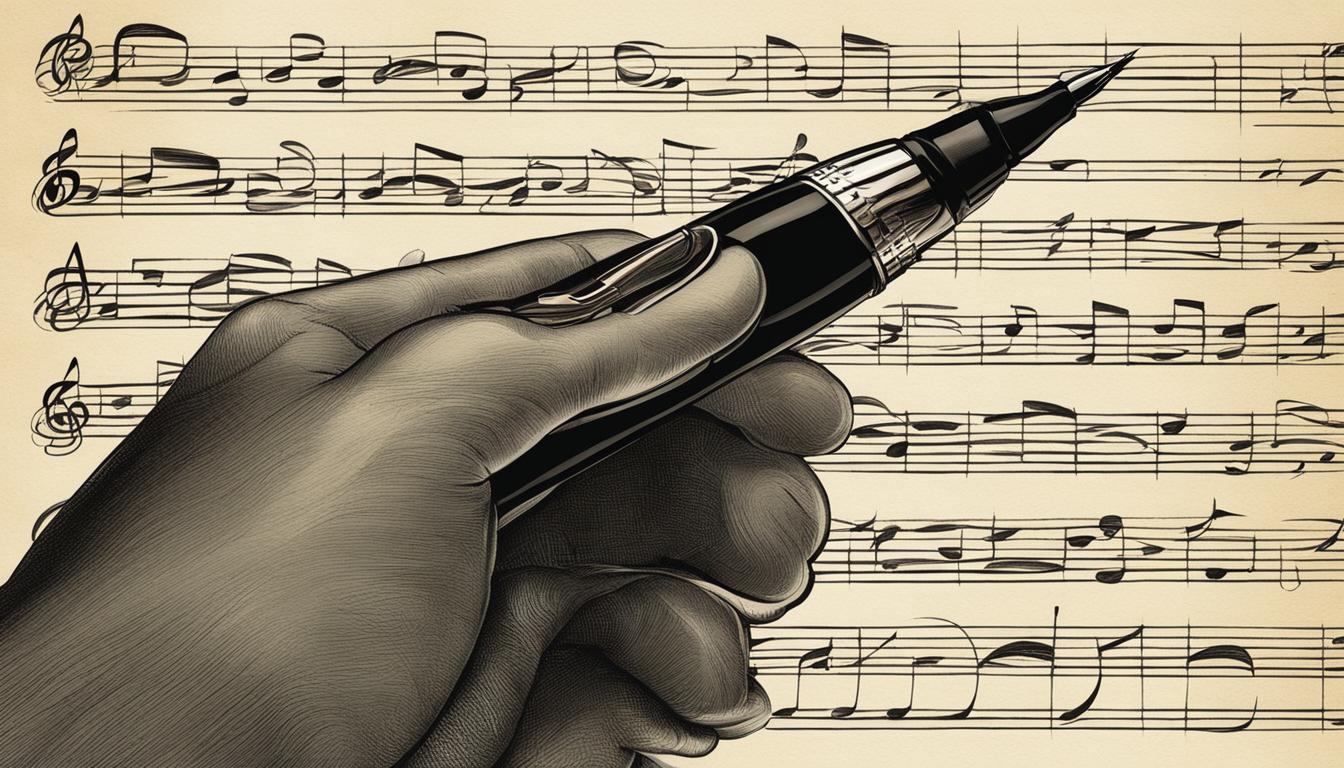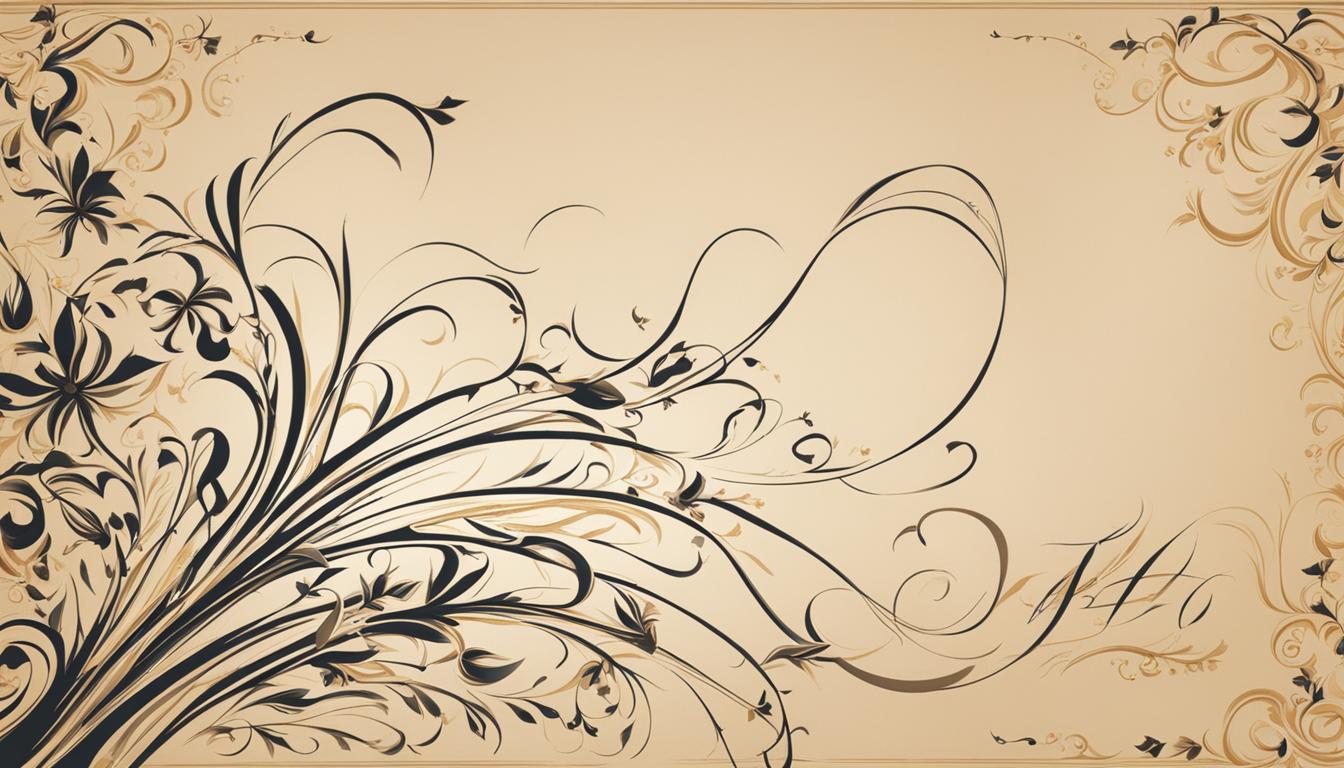Handwriting is a unique and irreplaceable form of self-expression. In today’s digital age, the value of handwriting is often overlooked, but it offers numerous benefits. It helps us connect with others, allows for creative expression, and improves memory and focus. Despite the rise of digital communication, there is still a place for the art of handwriting in our lives.
Key Takeaways:
- Handwriting is a valuable skill that offers benefits in communication, creativity, and cognition.
- Writing by hand allows for personal connection and self-expression.
- Handwriting stimulates memory and can enhance learning.
- Practicing handwriting improves legibility and beautiful writing.
- The art of handwriting is worth preserving and integrating into our daily lives.
The Joy and Importance of Handwriting
Handwriting is not just a mundane task; it is a source of joy and fulfillment. Each stroke of the pen is an opportunity to express ourselves and leave a tangible mark on the world. The unique beauty of handwriting lies in the fact that it is a deeply personal and individualistic form of communication. As we put pen to paper, our handwriting reflects our personality, our emotions, and our identity.
Handwriting is also a powerful tool for connection. When we receive a handwritten note or letter, we feel a sense of warmth and intimacy that is hard to replicate with a digital message. It allows us to slow down and truly connect with the sender, appreciating the effort and time they put into crafting their words. Handwritten communication holds a special place in our hearts, providing a personal touch that cannot be replicated by typing on a screen.
“Handwriting is a way of making one’s mark in the world. It is a way of saying, ‘I am here, and my voice matters’.”
In addition to the emotional benefits, handwriting offers cognitive advantages as well. Studies have shown that writing by hand stimulates the brain in unique ways, enhancing memory and learning. It engages both the motor and cognitive systems, improving hand-eye coordination and boosting creativity. Moreover, practicing handwriting exercises and techniques can refine our skills, resulting in more legible and aesthetically pleasing writing.
With all these reasons to celebrate the joy and importance of handwriting, it is clear that this timeless art form should not be overlooked in our increasingly digital world. Whether we are jotting down a quick note, crafting a heartfelt letter, or simply practicing our penmanship, let us embrace the joy of handwriting and keep this beautiful tradition alive.

The Benefits of Handwriting in the Digital Age
While technology continues to advance and dominate many aspects of our lives, the art of handwriting remains relevant and valuable. Handwriting offers a personal touch and connection that digital communication simply cannot replicate. It has emotional and sentimental value, and it plays a significant role in various professional settings. Moreover, handwriting provides a range of cognitive benefits, such as improved hand-eye coordination and enhanced creativity.
One of the unique advantages of handwriting is its ability to foster individuality and self-expression. When we write by hand, our handwriting becomes a reflection of our personality and personal style. This uniqueness can bring joy and fulfillment, both to the writer and the recipient of handwritten notes or letters.
Handwriting is not just a means of communication; it is an art form in itself. The practice of calligraphy, for instance, elevates handwriting to new heights of beauty and elegance. Calligraphy combines skilled penmanship with artistic flair, resulting in stunning letterforms and designs. Engaging in calligraphy and other handwriting techniques can not only improve the legibility of our writing but also enhance our creativity and artistic expression.
In a world where digital text dominates, taking the time to improve our handwriting skills can make a lasting impression. Whether it’s writing a thank-you note, creating a personalized card, or simply jotting down thoughts in a journal, the act of handwriting allows us to convey sincerity and thoughtfulness in a way that typing cannot. It adds a human element to our communication, making it more personal and meaningful.
While the digital age may continue to shape our lives, let us not forget the timeless art of handwriting. Embracing and improving our penmanship can bring forth a multitude of benefits, both personally and professionally. So, grab a pen, pick up a calligraphy guide, and rediscover the beauty and artistry of handwriting in the digital age.

The Beauty and Creativity of Handwriting

Handwriting is not just a practical skill; it is also a form of art that allows for creativity and self-expression. Just like any other art form, handwriting can be honed and developed to create beautiful letterforms and designs. Many famous writers and artists have attributed their creative thinking to the act of handwriting.
With handwriting, you have the freedom to experiment with different styles, sizes, and embellishments, making each piece unique. Whether you prefer flowing cursive or bold and blocky lettering, you have the power to create your own signature style.
Handwriting Heroes
“The idea of seeing your own thoughts in your own handwriting is very powerful.” – J.K. Rowling
J.K. Rowling, the author of the beloved Harry Potter series, is known for writing her novels by hand. She believes that the physical act of writing helps her connect with her imagination and tap into her creativity. By putting pen to paper, she is able to bring her ideas to life in a way that typing on a keyboard cannot replicate. Rowling’s dedication to handwriting is a testament to the beauty and power of this artistic skill.
Artistic handwriting can go beyond just pen and paper. It can be incorporated into various crafts and designs, such as calligraphy, hand-lettered signs, and personalized stationery. From creating intricate wedding invitations to adding decorative touches to scrapbooks and journals, handwriting adds a touch of elegance and personality to any project.
Handwriting as a Memory Aid
Writing by hand is not only a timeless art form but also a powerful tool for boosting memory and retaining information. Studies have shown that taking handwritten notes can enhance comprehension and recall compared to typing. When we write by hand, our brain actively processes the information, making it more likely to be stored in our long-term memory.
Practicing handwriting can also improve the legibility and beauty of our writing, making it a valuable skill for personal expression. By dedicating time to handwriting practice, we can refine our letterforms and develop a style that is uniquely our own. Whether it’s through journaling, letter writing, or simply jotting down notes, each instance of handwriting reinforces connections in our brain and enhances our ability to retain information.
Additionally, handwriting engages multiple senses, such as touch and kinesthetic movement, which further enhance memory retention. The physical act of writing activates different areas of the brain and creates a stronger neural pathway, making it easier for us to recall information later on. So, if you want to improve your memory while adding a touch of beauty to your written communication, practicing handwriting is the way to go!
The Decline of Handwriting and Its Importance
Handwriting, once a fundamental skill, is now facing a decline in our digital age. With the convenience of typing and the prevalence of digital communication, the quality of penmanship has suffered. Many individuals struggle with legible and consistent handwriting, leading to a loss of its personal touch and aesthetic appeal.
However, despite this decline, the importance of handwriting remains significant. Handwriting standards and penmanship are not simply relics of the past; they hold value in both personal and professional settings. In a world where digital communication dominates, the art of handwriting sets individuals apart, showcasing their attention to detail and personal style.
Furthermore, handwriting plays a vital role in literacy. The act of physically writing helps with cognitive development, as it engages multiple areas of the brain involved in motor skills, memory, and creativity. Handwriting allows us to better retain information and understand concepts. It also fosters self-expression and individuality.
By recognizing the importance of handwriting and investing in its preservation, we can ensure that future generations understand and appreciate this timeless skill. Teaching and practicing proper penmanship in schools and educational institutions is essential. Emphasizing handwriting standards not only improves legibility but also cultivates creativity and self-confidence.
In conclusion, while the decline of handwriting is evident, its importance should not be underestimated. Handwriting standards and penmanship are valuable assets that enhance communication, stimulate cognitive development, and foster personal expression. Let us work together to revive and maintain the art of handwriting, preserving its beauty and significance in our ever-evolving digital world.
Rediscovering the Art of Handwriting
In today’s digital age, the art of handwriting may seem to be fading away, but it is never too late to improve our penmanship skills. Handwriting workshops are a great way to rediscover the beauty and value of this timeless craft. These workshops provide an opportunity to learn and practice various handwriting techniques that can help us improve our penmanship.
During these workshops, experts guide participants through exercises and drills that focus on letter formation, spacing, and overall neatness. They also provide valuable tips and tricks to help us develop our own unique handwriting style. Through consistent practice and dedication, we can enhance our penmanship and bring back the joy of writing by hand.
Improving penmanship not only enhances the aesthetic appeal of our writing, but it also has cognitive benefits. Research shows that handwriting engages different parts of the brain, leading to improved memory and learning. By participating in handwriting workshops and actively working on our penmanship, we can unlock these cognitive benefits and enrich our overall cognitive abilities.
The Future of Handwriting
Despite the increasing digitalization of our lives, traditional handwriting is far from being completely forgotten. In fact, there is a growing movement to revive and preserve this beautiful art form. Handwriting enthusiasts, educators, and organizations are championing the importance of traditional handwriting, recognizing its unique value and benefits.
While technology has undoubtedly made communication quicker and more convenient, it cannot replicate the personal touch and emotional connection of handwritten words. Handwriting reflects our individuality and personality, and it has a timeless charm that digital communication often lacks. As such, there is a rising appreciation for the aesthetic and sentimental value of traditional penmanship.
The revival of handwriting is not solely rooted in nostalgia but also in the recognition of its cognitive benefits. Studies have shown that writing by hand engages different parts of the brain and can improve memory, cognition, and creativity. It also fosters better focus and comprehension, making it an invaluable skill in an increasingly distracted world.
Integrating Handwriting into Everyday Life
Handwriting is a timeless art form that can be integrated into our daily lives in various ways. Incorporating handwriting not only adds a personal touch to our communication but also allows us to reap the benefits of improved memory, creativity, and self-expression.
One way to incorporate handwriting is by writing personalized cards and notes. Whether it’s a heartfelt thank-you card, a thoughtful birthday message, or a simple “I miss you” note, handwriting adds a special touch that digital messages can’t replicate. It shows that we’ve taken the time and effort to express ourselves in a more meaningful way.
Journaling is another way to integrate handwriting into our daily lives. Writing down our thoughts, experiences, and reflections in a journal allows us to connect with ourselves on a deeper level. It becomes a personal keepsake that we can cherish and reflect upon in the future.

In addition to cards and journaling, we can also incorporate handwriting into crafts and art. From hand-lettered signs and calligraphy to creating unique artwork, handwriting adds an element of creativity and individuality to our creations. It allows us to unleash our artistic side and express our ideas in a visually appealing way.
By consciously choosing to write by hand in these various ways, we can make handwriting a part of our daily lives and experience the joy and benefits it brings. So, let’s embrace the art of handwriting and enjoy the beauty of penning our thoughts and emotions on paper.
The Importance of Handwriting Education
Handwriting education is a crucial element in preserving the art of handwriting and ensuring that future generations understand its value. Teaching penmanship in schools and educational institutions is essential to develop proper handwriting skills and foster an appreciation for this timeless art form.
By incorporating handwriting education into the curriculum, students can learn the fundamentals of penmanship, including letter formation, spacing, and legibility. This not only enhances their ability to communicate effectively but also instills a sense of pride and confidence in their written expression.
Furthermore, handwriting education goes beyond the mechanical aspects of writing. It encourages creativity and self-expression, allowing students to develop their unique handwriting style. By learning different writing techniques and practicing regularly, they can improve their penmanship and create beautiful, personalized written works.
Nurturing a Lifelong Skill
Investing in handwriting education equips students with a lifelong skill that extends beyond their academic years. The ability to write by hand is still highly valued in many professional and personal settings, and individuals with good penmanship often leave a positive impression.
Moreover, handwriting education helps students improve their cognitive abilities. Research has shown that writing by hand stimulates brain activity, enhances memory, and boosts overall learning. It also develops fine motor skills, hand-eye coordination, and spatial awareness, which are essential for various tasks in life.
Handwriting education is not just about teaching the mechanics of writing—it is about nurturing creativity, improving cognitive abilities, and instilling a sense of pride in one’s written expression.
By recognizing the importance of handwriting education, we can ensure that this valuable skill is passed down to future generations. Through dedicated teachers, comprehensive curricula, and a commitment to practicing and appreciating handwriting, we can preserve this beautiful art form and continue to reap its numerous benefits.
Conclusion
As we navigate the digital age, the art of handwriting has become a vanishing skill. However, its importance and value remain significant. Handwriting is more than just a means of communication; it is a form of self-expression, a connection to our past, and a tool for personal growth.
The art of handwriting allows us to leave our unique mark on the world. It enables us to infuse our personality and individuality into every stroke and curve. Whether we are crafting a heartfelt letter or simply jotting down notes, handwriting adds a personal touch that digital communication cannot replicate.
Though technology may make our lives more convenient, it cannot replace the emotional and sentimental value of handwriting. In a world where everything moves at a rapid pace, taking the time to write by hand allows us to slow down and savor each moment. It engages our senses and stimulates our creativity, serving as both a therapeutic practice and a means of artistic expression.
So, let us not lose sight of this beautiful skill. Let us cherish the art of handwriting and keep it alive in our lives. By embracing the art of handwriting, we can preserve a part of our history, enhance our cognitive abilities, and add a touch of beauty and authenticity to our everyday lives. Let us continue to write, to connect, and to celebrate the art of handwriting.
FAQ
Is handwriting still important in the digital age?
Yes, handwriting is still important as it offers a personal touch, emotional value, and is relevant in various professional settings.
Can handwriting improve memory and focus?
Yes, writing by hand stimulates creativity, improves memory, and aids in information retention.
How can handwriting be integrated into daily life?
Handwriting can be incorporated into activities such as writing cards, journaling, and incorporating it into crafts and art.
Can handwriting skills be improved?
Yes, through deliberate practice, dedication, and utilizing tools and resources such as calligraphy guides and tutorials.
What is the future of handwriting?
While handwriting may seem to be fading away, many individuals and organizations are advocating for its preservation and recognizing its unique value and benefits.
Is handwriting education important?
Yes, handwriting education plays a crucial role in teaching proper penmanship, fostering appreciation for the art of handwriting, and preserving this valuable skill.


